Ijraset Journal For Research in Applied Science and Engineering Technology
- Home / Ijraset
- On This Page
- Abstract
- Introduction
- Conclusion
- References
- Copyright
A Study on Effective Implementation of ERP Software in the Company
Authors: Pragadesh Karan P, Abisheck A, Gokul Kannan M, Krithika J
DOI Link: https://doi.org/10.22214/ijraset.2023.56344
Certificate: View Certificate
Abstract
Enterprise Resource Planning (ERP) software has emerged as a transformative technology for modern businesses, aiming to streamline processes, enhance collaboration, and improve overall operational efficiency. This research paper presents a comprehensive study on the effectiveness of ERP software implementation in various organizational contexts. The primary objective is to analyse the impact of ERP systems on business performance, operational efficiency, and decision-making processes. The findings of this study reveal that ERP software implementation leads to significant improvements in process efficiency and information visibility. Organizations that successfully integrate ERP systems experience reduced manual errors, enhanced data accuracy, and better resource utilization. Furthermore, the study highlights the importance of proper change management strategies during ERP implementation to mitigate resistance from employees and ensure a smooth transition. However, the research also identifies potential challenges, such as high upfront costs, complex customization requirements, and the need for continuous training and support. These challenges can impact the overall success of ERP initiatives. The paper underscores the significance of aligning ERP implementation with the organization\'s strategic goals and tailoring the software to meet specific business needs. In conclusion, this research contributes to the understanding of ERP software effectiveness by providing empirical evidence of its impact on operational performance and decision-making. The insights gained from this study can guide businesses in making informed decisions regarding ERP adoption, implementation strategies, and ongoing management. As organizations continue to navigate the digital transformation landscape, the findings of this research offer valuable insights into maximizing the benefits of ERP software to achieve long-term success and competitive advantage.
Introduction
I. INTRODUCTION
Organisations are constantly looking for ways to improve productivity, optimise operations, and maintain competitiveness in today's quickly changing business landscape. Enterprise Resource Planning (ERP) software is one of the creative solutions to these problems that have been made possible by the development of technology. ERP systems have emerged as comprehensive and integrated platforms made to speed up data-driven decision-making, simplify a variety of business processes, and increase productivity. This study examines how well ERP software implementations work in an effort to shed light on how well these systems live up to their claims of bringing about transformative change.
The integration of ERP software marks a pivotal shift in how organizations manage their resources and information. Traditionally, businesses relied on disparate systems and manual processes to handle various departments such as finance, human resources, supply chain, and customer relationship management. However, this approach often led to data silos, inefficiencies, and a lack of real-time visibility into crucial operations. ERP systems offer a holistic solution by consolidating these functions into a unified digital framework, enabling seamless communication, data sharing, and process synchronization.
The deployment of ERP software involves more than just technological adoption; it necessitates a re-evaluation of existing processes, a shift in organizational culture, and strategic alignment with business objectives. Despite the promises of enhanced efficiency and improved decision-making, ERP implementation can be intricate and challenging. Organizations must grapple with issues ranging from system customization and integration complexities to employee resistance and change management. Therefore, understanding the nuances of ERP effectiveness is crucial for organizations considering or undergoing this digital transformation.
The results of this study will add to the expanding amount of knowledge about ERP effectiveness as technology continues to change the business landscape. This study aims to provide a thorough understanding of how ERP systems can be harnessed to achieve sustainable competitive advantages in today's dynamic business environment by evaluating the impact of ERP software on operational processes, decision-making frameworks, and overall organisational success.
II. LITERATURE REVIEW
A Al-Mudimigh, M Zairi & M Al-Mashari ‘ERP software implementation: an integrative framework’ (2001) Concludes that It will depend on a balanced perspective that takes the organisation as a whole system into account. ERP implementation is a socio-technical challenge that necessitates a fundamentally different outlook from technologically-driven innovation. Behavioural processes and behaviours are thought to be important in ERP implementation. It is a process that combines macro- and micro-implementation at different operational and strategic levels. The deployment of the new systems will not necessarily produce the desired and anticipated results, which means that implementation in the context of ERP systems is not possible through an ON/OFF approach.
Michael Rosemann, Jens Wiese ‘Measuring the Performance of ERP Software – a Balanced Scorecard Approach’ (1999) concludes that setting goals for each criterion is just as important as choosing measures for each perspective on the balanced scorecard. The general planning principles must be applied in this situation, specifically the need to be demanding in order to inspire the personnel in charge while remaining sufficiently realistic to ensure that the budget can be implemented.
Finally, as much computerization as possible should be used in the information gathering, processing, and formatting processes in order to ensure that the ERP system operates not just effectively but efficiently. Traditionally, the delivery of an ERP system to users marks the conclusion of the process of controlling an investment. Approaches that are related to the ERP system's productive phase concentrate primarily on the cost-related financial effects. We also want to create a set of connected metrics based on the Balanced Scorecard that go beyond financial key performance indicators to provide a more comprehensive understanding of the performance of the ERP system.
Jacques C. Verville, Alannah Halingten ‘A qualitative study of the influencing factors on the decision process for acquiring ERP software’ (2002). They concentrated on the factors that affected and defined the enterprise resource planning (ERP) acquisition process (ERPAP) as discovered through a multiple-case analysis of four organisations that had purchased ERP solutions. Webster and Wind's (Prentice-Hall, Englewood Cliffs, NJ, 1972) organisational buying behaviour (OBB) served as the foundation for classifying the influences that came to light during the study. The research presented here highlights variables (influences and characteristics) specific to the buying situation for ERP software packages, whereas Webster and Wind's model presents a broad scope of variables that may affect organisational buying without differentiating those variables that are dependent on specific buying situations. There were many influences, but the users' influence stood out as the most significant. Additionally, five salient traits were identified. A future study of these influences could examine the extent to which they impact the ERPAP and could serve to help organizations minimize those that are shown to hinder it.
Pollyanne S. Frantz, Arthur R ‘ERP Software Implementation Best Practices’ (2002). the James T. Johnson Southerland. examined the opinions of chief information and financial officers regarding the ideal methods for implementing enterprise resource planning (ERP) software. 159 respondents provided usable responses, which, for the most part, demonstrate agreement between the two groups' perceptions and outline some best practises that serve as common ground. (SLD)
III. PROBLEM STATEMENT
The purpose of this study is to systematically examine the effectiveness of ERP software implementations in order to provide a clear understanding of their impact on organizational performance, operational efficiency, and decision-making processes, thereby guiding informed decision-making for organizations considering or undergoing ERP adoption.
This study will provide organizations with evidence-based insights into the actual outcomes of ERP software implementations, offering a comprehensive understanding of their impact on various aspects of operations and decision-making. The findings will guide organizations in making informed decisions about ERP adoption, implementation strategies, and ongoing management, ultimately helping them maximize the benefits of ERP systems and navigate potential challenges more effectively. As a result, the problem statement for this study may be:
‘Assess the actual impact of ERP software implementations on organizational effectiveness and decision-making, bridging the gap between expectations and outcomes.’
IV. RESEARCH GAP
This study lies in the lack of a comprehensive and standardized framework for assessing the true effectiveness of ERP software implementations. While ERP systems are widely adopted with expectations of transformative outcomes, empirical evidence regarding their impact on organizational performance, operational efficiency, and decision-making remains fragmented and Conclusive, necessitating a rigorous investigation to bridge the gap between anticipated benefits and actual outcomes.
V. OBJECTIVE OF RESEARCH
The objective of this research is to assess the effectiveness of ERP (Enterprise Resource Planning) software implementations in various organizational contexts.
VI. METHODOLOGY
- Research Design: Descriptive Research
- Sample Technique: Convenient technique
- Sample Size: 50 Respondents
A. Data Collection
There is a significant difference in key performance indicators (KPIs) between organizations before and after ERP software implementation, indicating a positive impact on operational efficiency and organizational performance. Collect qualitative data to gain insights into the challenges, opportunities, and experiences associated with ERP implementation. This could be involving survey. Surveys: Administer surveys to gather opinions and perceptions from a broader sample of employees involved in the ERP implementation process.
B. Data Analysis
Employ thematic analysis to identify recurring themes, patterns, and insights from interviews, surveys, and observations.
C. Hypothesis formulation
Hypothesis:
- H0: The decision-making processes of organizations do not significantly improve after the adoption of ERP software.
- H1: The decision-making processes of organizations significantly improve after the adoption of ERP software, leading to more informed and strategic choices.
D. Approach
- Synthesize the findings from qualitative analyses.
- Draw conclusions about the overall effectiveness of ERP implementations.
- Provide practical recommendations for organizations, considering both technological and organizational factors.
- Present research findings in a comprehensive manner, utilizing visualizations, tables, and qualitative excerpts.
VII. ANALYSIS AND INTERPRETATION:
Before evaluating the responses using statistical tools, we went through the responses as such to understand the Employee’s mind-set on the after the implementation of the ERP software.
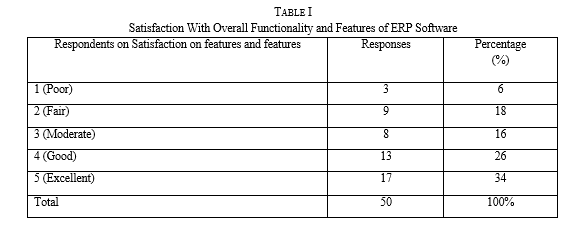

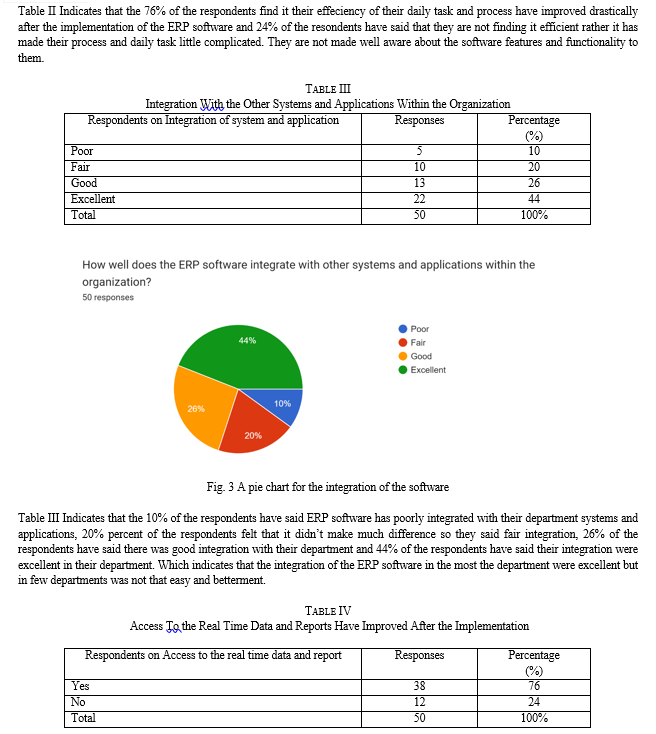
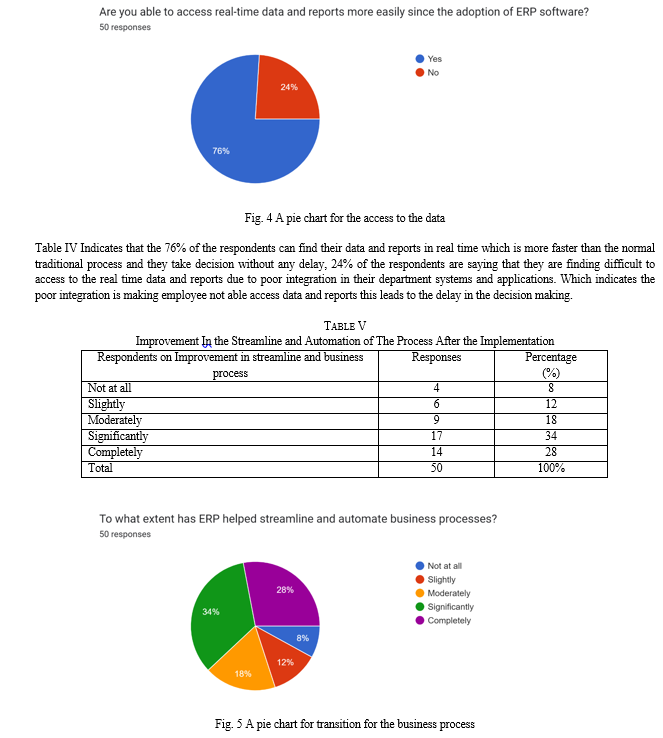
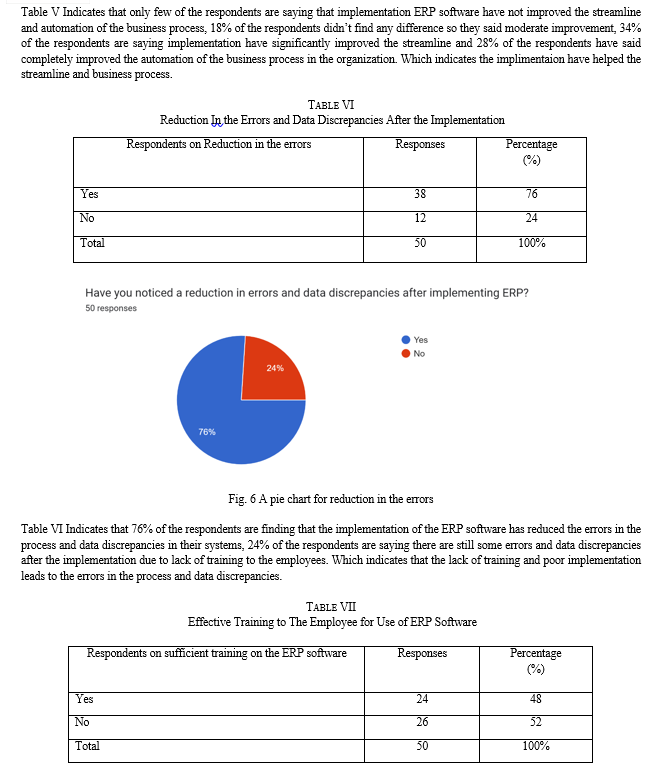


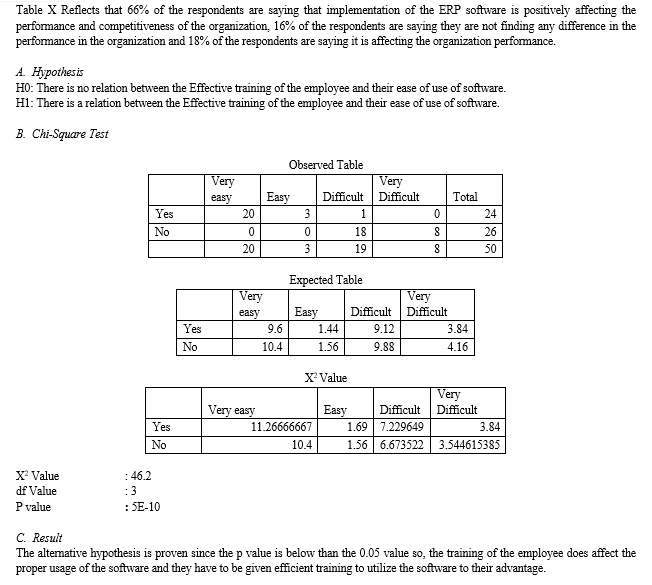
VIII. RECOMMENDATIONS
- Further Research: Although the current analysis points to a impact and improvement of the organization performance, it is important to do a through and in-depth studies to examine the potential improvement in performance and automation of the business process. To better understanding of this concepts and decision-making process, this may use quantitative studies, questionnaire and interviews for this study.
- Strategic Alignment: Based on the positive impact observed in operational efficiency and decision-making, organizations are encouraged to align ERP implementation with their strategic goals. This alignment ensures that ERP systems are configured and utilized to drive desired outcomes.
- Change Management Emphasis: Given the challenges highlighted during ERP implementation, organizations should prioritize robust change management strategies. Addressing employee concerns, providing comprehensive training, and fostering a culture of adaptability can contribute to smoother transitions.
- Industry-Specific Customization: Recognizing industry-specific effects on ERP effectiveness, organizations should consider tailoring ERP implementations to address unique operational and regulatory requirements within their sector.
- Documentation and Training: Document ERP implementation processes, lessons learned, and best practices for future reference. Additionally, establish comprehensive training programs to equip employees with the skills needed to leverage the ERP system effectively.
- Continuous Monitoring and Evaluation: Implement mechanisms for ongoing monitoring and evaluation of ERP performance. Regularly assess KPIs and adjust the ERP system as needed to maintain optimal functionality and benefits.
IX. RESULTS
The effectiveness of ERP software would encompass a comprehensive assessment of the impact of ERP implementation on organizational performance, operational efficiency, and decision-making processes. Evidence of improved decision-making processes resulting from access to real-time data, enhanced data accuracy, and better information visibility across the organization.
Qualitative and quantitative evidence showcasing the integration and streamlining of business processes, reducing redundancy, improving cross-functional communication, and enhancing overall process efficiency. Insights into effective change management strategies that mitigated resistance and facilitated a smoother transition during ERP implementation, showcasing the importance of employee engagement and communication. Identification of common challenges faced during ERP implementation, such as customization complexities and integration issues, along with lessons learned and strategies to overcome these challenges.
Conclusion
In analysing the impact of ERP software on organizational performance and decision-making, this study unveils a notable positive influence. ERP implementations led to enhanced operational efficiency, streamlined processes, and improved decision-making through real-time data access. However, challenges in customization and change management were acknowledged, emphasizing the need for strategic planning. The findings present a compelling case for aligning ERP implementation with organizational objectives, underscoring its potential as a catalyst for sustainable growth and competitive advantage in the digital age. The study serves as a valuable guide for organizations aiming to optimize their ERP investments and stride confidently into an era of improved efficiency and informed decision-making.
References
[1] Al-Mudimigh, M Zairi & M Al-Mashari. (2001), ERP software implementation: an integrative framework. European Journal of Information Systems, 10:4, 216-226. https://doi.org/10.1057/palgrave.ejis.3000406 [2] Frantz, P.S., Southerland, A.R. & Johnson, J.T. (2002), ERP Software Implementation Best Practices. Educause Quarterly, 25(4), 38-45. https://www.learntechlib.org/p/97622/ [3] Rosemann, Michael & Wiese, Jens. (1999), Measuring the Performance of ERP Software: A Balanced Scorecard Approach. 10th Australasian Conference on Information Systems. https://www.researchgate.net/publication/228600204_Measuring_the_Performance_of_ERP_Software_a_Balanced_Scorecard_Approach [4] Verville, J.C. and Halingten, A. (2002),\"A qualitative study of the influencing factors on the decision process for acquiring ERP software\", Qualitative Market Research, Vol. 5 No. 3, pp. 188-198. https://doi.org/10.1108/13522750210432995 [5] Alan R. Peslak, Girish H. Subramanian & George E. Clayton. (2008), The Phases of ERP Software Implementation and Maintenance: A Model for Predicting Preferred ERP Use, Journal of Computer Information Systems, 48:2, 25-33. https://doi.org/10.1080/08874417.2008.11646006 [6] Dorothy M. Fisher, Melody Y. Kiang, Steven A. Fisher & Robert T. Chi. (2004), Evaluating Mid-Level ERP Software, Journal of Computer Information Systems, 45:1, 38-46. https://doi.org/10.1080/08874417.2004.11645815
Copyright
Copyright © 2023 Pragadesh Karan P, Abisheck A, Gokul Kannan M, Krithika J. This is an open access article distributed under the Creative Commons Attribution License, which permits unrestricted use, distribution, and reproduction in any medium, provided the original work is properly cited.

Download Paper
Paper Id : IJRASET56344
Publish Date : 2023-10-28
ISSN : 2321-9653
Publisher Name : IJRASET
DOI Link : Click Here
 Submit Paper Online
Submit Paper Online

